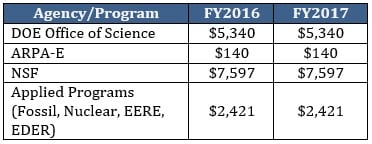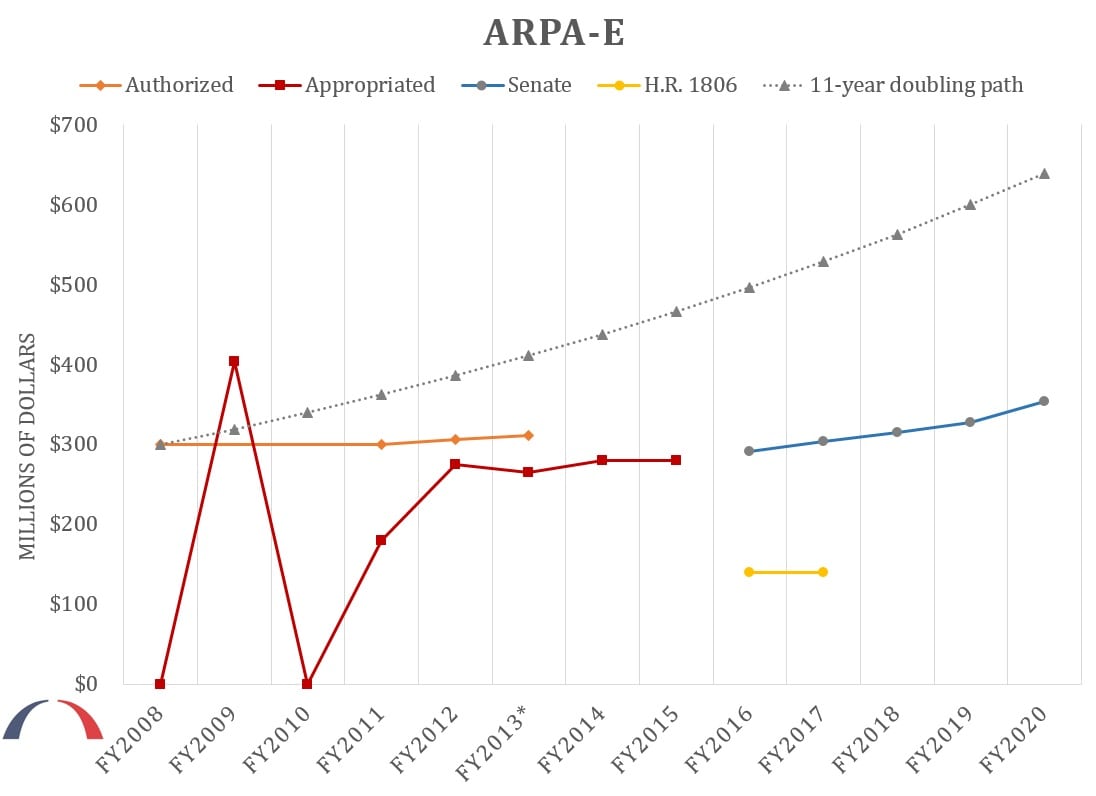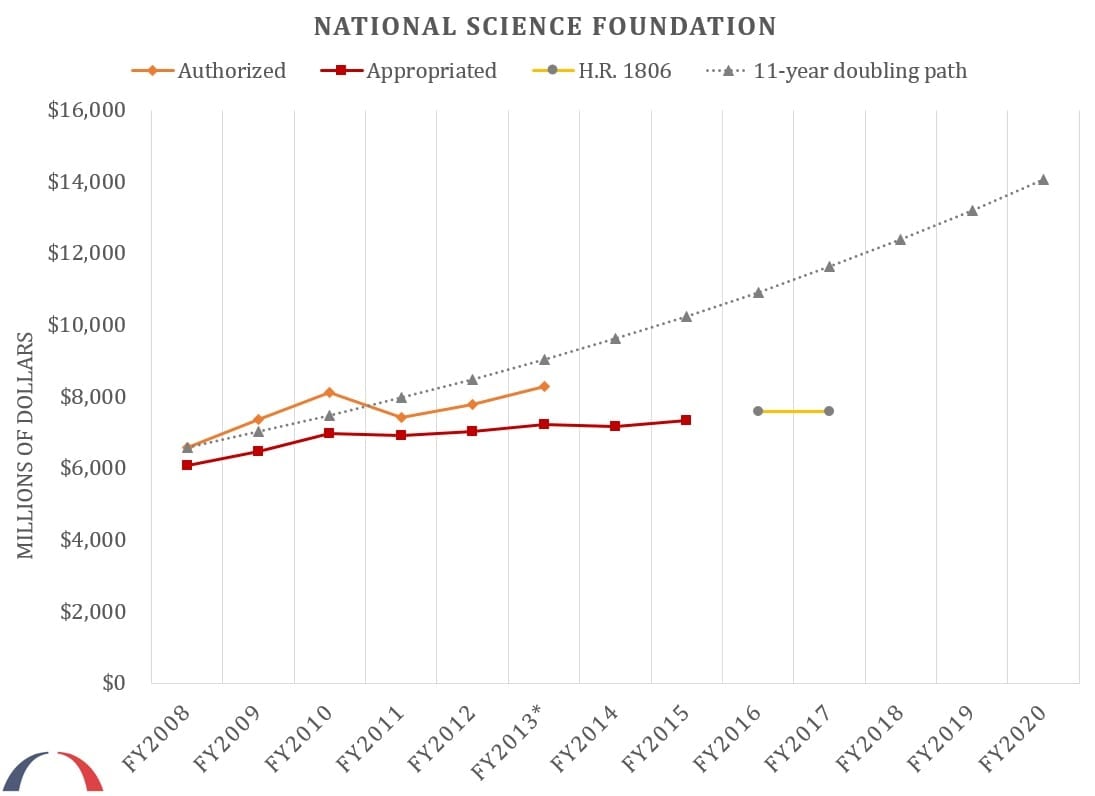Getting Back on Track: The America COMPETES Reauthorization Act
Energy innovation is rising to a priority discussion in the United States, as last week both chambers of Congress acted on legislation that will guide the course of federal science and R&D investments for years to come. The House of Representatives narrowly passed its version of the America COMPETES Reauthorization Act (H.R. 1806), while in the Senate a bipartisan set of seven members introduced their version of energy-specific provisions in America COMPETES.
BPC’s American Energy Innovation Council (AEIC) strongly supports a robust reauthorization of the America COMPETES Act to restore U.S. leadership in energy innovation. Consistent and increasing authorizations for energy innovation investments are necessary to produce energy technology breakthroughs that strengthen American companies’ competitiveness in global technology markets and ensure U.S. economic growth.
What is the America COMPETES Act?
The America Creating Opportunities to Meaningfully Promote Excellence in Technology, Education, and Science (COMPETES) Act?both the original 2007 bill, signed by President George W. Bush, and its 2010 reauthorization, signed by President Barack Obama?were bipartisan legislative achievements to strengthen U.S. economic competitiveness through science and innovation policy. The America COMPETES Act authorizes federal investments in science and early-stage technology research and development (R&D), as well as in science, technology, engineering, and mathematics (STEM) education. Authorizing provisions of the America COMPETES Act expired at the end of FY2013.
How is energy innovation included in the America COMPETES Act?
Several measures of the America COMPETES legislation are particularly salient for increasing public investments in energy innovation. These include authorizations for funding of:
- The Advanced Research and Projects Agency-Energy (ARPA-E);
- The Department of Energy (DOE) Office of Science, particularly for basic energy sciences (BES); and
- The National Science Foundation (NSF), particularly for research and research-related activities (R&RA).
In additional to energy innovation, America COMPETES authorizes other measures, including STEM education and workforce programs, research programs, and innovation programs at non-DOE agencies that contribute to the broader goals of energy innovation-driven growth and competitiveness. As a result, responsibility for the bill is spread across multiple committees, with the Committee on Science, Space, and Technology reporting the bill in the House and the Committee on Commerce, Science, and Transportation reporting the bill in the Senate.
Committees of Jurisdiction for America COMPETES
House
- Science, Space, and Technology (Dept. of Energy & Dept. of Commerce)
- Education and the Workforce (Dept. of Education)
Senate
- Commerce, Science, and Transportation (Dept. of Commerce)
- Energy and Natural Resources (Dept. of Energy)
- Health, Education, and Labor (Dept. of Education)
Timeline of Events
Current legislative activity on America COMPETES legislation follows 10 years of previous work by experts, Congresses, and administrations under both parties’ leadership.
May 2005: In response to a bipartisan Congressional request for a science and technology strategy to enhance U.S. competitiveness, the National Academies creates the Committee on Prospering in the Global Economy of the 21st Century, chaired by AEIC principal Norm Augustine and including CEOs of Fortune 100 companies, Nobel laureates, major universities, and former officials of both parties.
2007: The committee publishes the report, Rising Above the Gathering Storm, which identifies two key challenges for American competitiveness: creating high-quality jobs and responding to the nation’s need for clean, affordable, and reliable energy. The report lays out several recommendations to improve STEM education, attract and train STEM graduates, increase public investments in basic research, and create incentives for technology innovation.
August 2007: Congress passes the America COMPETES Act of 2007.
2010: The National Academies publishes a follow up report that finds the U.S. competitive posture has worsened, as the progress of other nations, particularly China, is outpacing the efforts of the U.S.
December 2010: Congress passes the America COMPETES Re-authorization Act of 2010.
October 2013: The authorizing provisions of the America COMPETES Act expire.
September 2014: Under the American Academy of Arts and Sciences, a similar committee again chaired by AEIC principal Norm Augustine publishes an additional follow up report that finds the U.S. is failing to keep pace with other countries’ investments in R&D and STEM education.
Summary: The America COMPETES Act of 2007
Congress passed the original America COMPETES Act with strong bipartisan support on August 2, 2007, and it was signed into law by Republican President George W. Bush shortly thereafter. It passed the Senate by unanimous consent, and it passed the House by 367?57.
The law authorized $33.6 billion in appropriations between FY 2008-10, with R&D funding levels at NSF and DOE Office of Science at a growth rate (10.3%) consistent with a 7-year doubling path. Additionally, the law authorized ARPA-E for the first time.
America COMPETES was not fully funded, and a number of initiatives did not receive appropriations.
Energy-relevant Agencies/Programs FY 2008-2010 ($ millions)
Energy-relevant Agencies/Programs FY 2011-2013 ($ millions)
America COMPETES in the Senate
Last week, Sen. Lamar Alexander (R-TN), along with co-sponsors Senators Chris Coons (D-DE), Lisa Murkowski (R-AK), Maria Cantwell (D-WA), Cory Gardner (R-CO), Dianne Feinstein (D-CA) and Martin Heinrich (D-NM), introduced an energy-only section of America COMPETES. The bipartisan bill would extend authorizations for energy innovation investments through 2020. The annual funding growth rate for DOE Office of Science (4%) puts it on an 18-year doubling path, rising above the FY2013 authorization level only in FY2020. The average annual funding growth rate for ARPA-E (5%) puts it on a 14-year doubling path, rising above the FY2013 authorization level in FY2018.
Additionally, the bill consolidates and eliminates certain STEM programs.
Senate Bill:
Energy-relevant Agencies/Programs FY 2016-2020 ($ millions)
America COMPETES in the House
Last week, the House voted along party lines to pass a full America COMPETES bill. The bill extends authorizations for energy innovation investments for only two years at fixed levels. The bill cuts authorizations for ARPA-E to 50% of FY2015 appropriations. The bill increases DOE Office of Science and NSF authorizations by 5% and 3%, respectively, from FY2015 appropriations levels. In contrast to the 2007 and 2010 bills, the House bill also includes DOE applied energy R&D programs (Fossil, Nuclear, Energy Efficiency and Renewable Energy (EERE), Electricity Delivery and Energy Reliability (EDER)) and cuts their authorizations by 31% from FY2015 appropriations levels.
The bill also modifies National Labs authority and institutes programs to promote technology transfer. Additionally, the bill sets authorizations for a number of other non-DOE science and technology programs, modifies STEM programs, and institutes oversight policies regarding federally-funded research.
H.R. 1806:
Energy-relevant Agencies/Programs FY 2016-2017 ($ millions)
The Doubling Trajectory for R&D
First initiated in FY2006, Congress and successive administrations have sought to double funding for core science agencies, including DOE’s Office of Science, ARPA-E, and NSF. The original 2007 America COMPETES set a 7-year doubling path for science agencies’ budgets, and the 2010 reauthorization set an 11-year doubling path.
Appropriations have fallen short of authorized levels most years, and appropriations have even declined some years as authorizations increased. Even with commitment to increasing energy innovation investments in the next reauthorization of America COMPETES, historic underfunding kicks the can down the road on the original COMPETES vision of doubling U.S. energy innovation investments.
* FY2013 numbers do not reflect reductions from budget sequestration
BPC and AEIC strongly support consistent and growing authorizations for ARPA-E, DOE’s Office of Science, and other innovation investments critical to U.S. economic competitiveness. Other countries are raising their public energy RD&D investments and claiming global technology market share?particularly China. The United States must commit to greater and smarter investments in energy technology now to capture its remarkable energy promise and take advantage of the competitiveness opportunities they afford.
Share
Read Next
Support Research Like This
With your support, BPC can continue to fund important research like this by combining the best ideas from both parties to promote health, security, and opportunity for all Americans.
Give NowRelated Articles
Join Our Mailing List
BPC drives principled and politically viable policy solutions through the power of rigorous analysis, painstaking negotiation, and aggressive advocacy.






